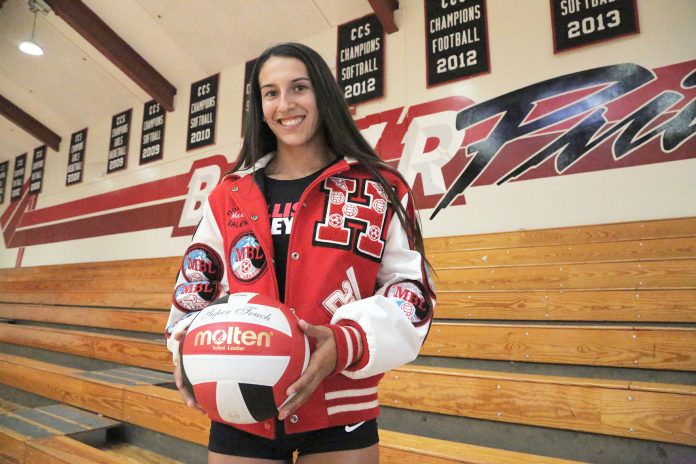The Nov. 18, 2002 cover of Sports Illustrated featured an iconic shot of Brian Brohm, who at the time was a star junior quarterback at Trinity High in Kentucky. The subtitle of the cover story, “Inside the changing world of our young athletes,” was the first of a four-part series that detailed a semi-revolution in high school sports, where the top athletes started specializing in one sport rather than play multiple ones.
Part one was entitled, “The vanishing three-sport star”, highlighting a variety of reasons why the best multi-sport athletes in metropolitan areas of the country were an endangered species. Nearly 14 years later, senior Marisa Villegas has bucked the trend in an era where specialization has become the norm.
From the moment Villegas enrolled at San Benito High, she had made up her mind that she was going to play three sports: volleyball in the fall, soccer in the winter and track and field in the spring. Unfortunately for Villegas, there isn’t a fourth season in high school sports.
“If there was an another season, I would play basketball,” said Villegas, who started playing club basketball in the third or fourth grade before having to give up hoops for soccer because both of those sports are played in the same season in high school. “It was one of hardest decisions I’ve had to make. It’s always hard to give up a sport when you’ve played it for several years.”
Why has the three-sport star become the exception rather than the norm in the prep sport world? It starts with competition. A greater pool of athletes are competing for a finite amount of scholarships. Villegas’ mom, Marlene, a 1990 San Benito High graduate who has been a P.E. teacher at the school for 20 years, has seen the pursuit firsthand.
“I’ve never seen such passion to play sports in college the way I do now,” said Villegas, the longtime San Benito girls volleyball assistant coach who is also the athletic director and volleyball coach at Southside School.
Competition, in turn, has led to athletes focusing on one sport year-round through club/traveling teams. The emergence of club/traveling organizations in the 1970s and the ensuing boom in the following decades is perhaps the biggest reason why there are fewer multi-sport athletes.
That’s because athletes get noticed during high-profile showcase tournaments on the club schedule, and less so during the high school season.
“You don’t get recruited during the high school volleyball season—you get recruited during the club season,” Marlene Villegas said. “That is where you get more action and looks.”
College coaches might attend a high school game to watch a player they’re high on, but increasingly they attend showcase events because of the potential to see other potential prospects. With increased competition, athletes know if they’re not playing a sport year-round, they risk falling behind because everyone else is.
Club coaches also expect a huge commitment from their athletes, and for good reason.
“I want my athletes to commit to the sport, and I want them to be all in,” said Dean Askanas, the Lynbrook High girls volleyball coach who coached girls volleyball at San Benito High for 10 years and is a longtime club coach. “I don’t want all my athletes to be playing basketball and soccer and all that. As coaches, we want them to commit to improve and get as strong as they can get in the sport they’re playing.”
One only has to take a look at the San Benito High baseball team to see the club/travel ball effect. Despite not having won a Central Coast Section championship, the Haybalers are a perennial power, one of the top ten programs in the entire Bay Area—bar none. Every year, they send multiple players to four-year programs.
On last year’s team, all but two players played for a traveling team. The top teams in every sport is comprised of athletes who play the sport year-round. Most of the San Benito baseball players play for Trosky Baseball, the Watsonville Aggies and California Club Baseball.
All of these organizations play in summer showcase tournaments in front of scouts and college coaches. Balers coach Billy Aviles, who coaches various teams with Trosky Baseball, said the right clubs will get the players in a premium position for maximum exposure.
“Trosky and CCB play in the right tournaments that will get you in front of a lot of people,” he said. “It just takes one person to like you and get you that scholarship to further your education.”
Villegas doesn’t have a scholarship offer on the table—yet. However, it wouldn’t be a surprise if a Division I program offers her one by the end of the school year. Even if that doesn’t happen, Villegas and her family couldn’t be happier with the decision they’ve made to forgo the club scene once Marisa got to high school.
“I don’t think it would’ve been worth it to focus on one sport,” Villegas said. “If I just run throughout my entire high school career, I might have gotten burned out and not loved it so much.”
Even though Villegas didn’t run cross country in high school, she’s on track to do cross country and track in college. Villegas’ talent is that good, and the only real question is if she receives scholarship money or if she’ll have to wait a year or two to earn scholarship status.
Villegas took an official visit to UC Berkeley two weeks ago, spending 48 hours on campus immediately after helping the Balers win the Cupertino Classic tournament. Last weekend, Villegas took an official visit to UCLA. In the next month or two, she’ll peruse the campuses of USC and Cal Poly before making her choice.
What is Villegas’ favorite sport? Whatever sport she’s playing. Even though at one time in her life shooting a basketball was her favorite thing to do, Villegas hasn’t launched a single shot in high school. That’s because she’s been too busy with volleyball, then soccer, then track, then summer volleyball, before the cycle repeats itself.
That Villegas plays two sports at a high level makes her rare enough. Marlene has always felt that it was important for athletes to have a well-rounded experience in high school.
“Of course I’m biased because I’m in PE, and I love all the sports,” Marlene said. “I love seeing multiple-sport athletes. Marisa always wanted to play more than one sport. She never got bored with one sport, but was always so excited to start another new sports season.”
Marlene and her husband, Lalo, have three daughters: Marisa, Maya, who is a freshman at San Benito, and Mia, a seventh grader at Southside. It was the parents’ mindset to allow their daughters to play what they love—however many sports that may be—rather than push them to stick with one.
The family and a number of coaches acknowledge that had Marisa focused on one sport, she would’ve increased her chances of landing an athletic scholarship by now. However, neither Marisa nor Marlene have any regrets. On the contrary, Marisa wouldn’t have enjoyed her high school experience nearly as much had she decided to stick with one or even two sports.
“I’m actually getting sad volleyball season is already halfway over,” she said. “I’m glad I played all three sports. There will be a time soon when I’ll have to give up volleyball and soccer, and I’m totally fine with that. I just couldn’t have imagined not playing those sports for this long.”
Interestingly enough, Villegas has never suffered a serious injury despite playing sports year-round. No doubt, Villegas has plenty of wear and tear on her body, as she only takes off three to four weeks out of the entire year to rest her body. There’s a big debate these days on whether specializing in a sport leads to more injuries.
“Specialization is causing an injury rate that never occurred when people played three sports and used different muscle groups,” Dan Lebowitz said in USA Today. Lebowitz is executive director of the Center for the Study of Sport in Society at Northeastern University. “And the demands in terms of coaches wanting a year-round commitment is crazy, so the whole mindset has changed.”
Critics say athletes focusing on one sport have a greater chance of suffering an injury due to repetitive motion. If this is indeed the case—and the jury is still out on this—then athletes are caught in a catch-22. For every Marisa Villegas, there are thousands more who need to focus on one sport to make a varsity team.
Gone are the days when kids could just roll into practice without being in peak shape and expect to be an impact player. Nowadays, the best players start a season having already put in hundreds of hours of work in the off-season through their club team and individual workouts.
In her talks with college coaches, Marlene said it was a refreshing surprise to hear that they had no problem with Marisa bypassing cross country in favor of volleyball. That’s probably because Villegas will come into college with less mileage on her legs, along with the fact that basic athleticism and skills carry over from sport to sport.
Translation: overall athleticism helps in every sport, no matter how different they are. Club/traveling teams have become big business, though most of them are still relatively affordable. In the Bay Area, volleyball club programs tend to be more expensive than their baseball or basketball counterparts.
“I would say by far volleyball is the most expensive,” Askanas said. “I don’t know why, the reasoning or the justification, but only that they can simply charge it and people will pay it.”
Now more than ever, the top recruits are playing and specializing in one sport. Marisa Villegas will walk the hallways of San Benito for 7 ½ more months, knowing she had made the most of her high school experience.










